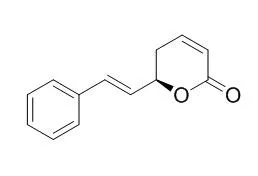| Description: |
Goniothalamin is a natural product that has been demonstrated to induce apoptosis in various cancer cell lines, can induce cytotoxicity and apoptosis on RT4 cells, induce apoptosis on HepG2 liver cancer cells via induction of caspase-3 with less sensitivity on the cell line of Chang cells. Goniothalamin has gastroprotective activity which is inhibited after pre-treatment with NEM (N-ethylmaleimide) and NSAID (non-steroidal anti-inflammatory drugs), highlighting the importance of sulfhydryl compounds and prostaglandins on Goniothalamin activity. Goniothalamin induces oxidative stresses and inhibits the expression of cell wall-associated proteins resulting in growth inhibition of Arabidopsis seedlings. |
| Targets: |
ATPase | HSP (e.g. HSP90) | NO | Nrf2 | Caspase |
| In vitro: |
| BMC Complement Altern Med. 2014 Aug 9;14:295. | | Involvement of Seladin-1 in goniothalamin-induced apoptosis in urinary bladder cancer cells.[Pubmed: 25107315] | Goniothalamin is a natural product that has been demonstrated to induce apoptosis in various cancer cell lines. In this study, we have elucidated the role of Seladin-1 in Goniothalamin-induced cytotoxicity towards human urinary bladder cancer cell line RT4.
METHODS AND RESULTS:
The cytotoxicity of Goniothalamin in human urinary bladder cancer cell line RT4 was assessed using MTT assay and the mode of cell death was determined by Annexin V-FITC/PI labeling assay. Finally, the expression of Seladin-1 protein in Goniothalamin-treated RT4 cells was determined by Western blot. MTT assay showed that the cytotoxicity of Goniothalamin on RT4 cells was concentration and time dependent with IC50 values of 61 μM (24 hr), 38 μM (48 hr) and 31 μM for 72 hr, respectively. Cell death induced was confirmed through apoptosis; as assessed using the Annexin V-FITC/PI labeling assay. Furthermore, the involvement of Seladin-1 in Goniothalamin-induced apoptosis was evidenced through the cleavage of 60 kDa protein to 40 kDa and 20 kDa. This was followed by a gradual increase of 20 kDa fragment suggesting the involvement of Seladin-1 in Goniothalamin-induced apoptosis on RT4 cells.
CONCLUSIONS:
This study demonstrates that Goniothalamin induce cytotoxicity and apoptosis on RT4 cells. The involvement of Seladin-1 in Goniothalamin-induced apoptosis further suggested that Seladin-1 may play a role in the formation of primary bladder cancer. | | Nat Prod Commun. 2015 May;10(5):725-7. | | Transcriptomic evaluation of plant growth inhibitory activity of goniothalamin from the Malaysian medicinal plant Goniothalamus andersonii.[Pubmed: 26058144] | Goniothalamin produced by the Malaysian medicinal plant, Goniothalamus andersonii J. Sinclair, strongly inhibits plant growth. However, its mode of action has not been characterized at the gene expression level.
METHODS AND RESULTS:
We conducted DNA microarray assay to analyze the changes in early gene responses of Arabidopsis thaliana seedlings. After a 6-h exposure to Goniothalamin, we observed an upregulation of genes highly associated with heat response, and 22 heat shock protein (AtHSP) genes were upregulated more than 50 fold. Together with these genes, we observed upregulation of the genes related to oxidative stress and protein folding. Also, the genes related to cell wall modification and cell growth, expansin (AtEXPA) genes, were significantly downregulated.
CONCLUSIONS:
The results suggested that Goniothalamin induces oxidative stresses and inhibits the expression of cell wall-associated proteins resulting in growth inhibition of Arabidopsis seedlings. |
|
| In vivo: |
| Chem Biol Interact. 2014 Nov 10;224C:206-212. | | Gastroprotective effects of goniothalamin against ethanol and indomethacin-induced gastric lesions in rats: Role of prostaglandins, nitric oxide and sulfhydryl compounds.[Pubmed: 25451594] | Goniothalamin (GTN), a styryl-lactone, is a secondary metabolite naturally found in its enantiomeric form (R) in plants of the genus Goniothalamus (Annonaceae).
METHODS AND RESULTS:
Our group reported on the in vivo activity of (R)- and (S)-Goniothalamin as well as its racemic form (rac-Goniothalamin) in both Ehrlich solid tumor and carrageenan-induced paw edema in mice, without side effects in the effective doses. Despite the rich body of data on the in vitro Goniothalamin biological activity, much less is known about its in vivo pharmacological action. Herein we describe the gastroprotective activity of rac-Goniothalamin on chemical-induced gastric ulcers models in rats. Goniothalamin has a potent gastroprotective effect on ethanol-induced ulcers (effective dose50=18mg/kg) and this activity is dependent on sulfhydryl compounds and prostaglandins generation, but independent of nitric oxide (NO), gastric secretion and mucus production.
CONCLUSIONS:
This hypothesis is supported by the fact that Michael acceptors are the most potent inducers of antioxidant response (as activation of Nrf2 pathway) through generation of mild oxidative stress and that gastroprotective activity of Goniothalamin is inhibited after pre-treatment with NEM (N-ethylmaleimide) and NSAID (non-steroidal anti-inflammatory drugs), highlighting the importance of sulfhydryl compounds and prostaglandins on Goniothalamin activity. |
|






 Cell. 2018 Jan 11;172(1-2):249-261.e12. doi: 10.1016/j.cell.2017.12.019.IF=36.216(2019)
Cell. 2018 Jan 11;172(1-2):249-261.e12. doi: 10.1016/j.cell.2017.12.019.IF=36.216(2019) Cell Metab. 2020 Mar 3;31(3):534-548.e5. doi: 10.1016/j.cmet.2020.01.002.IF=22.415(2019)
Cell Metab. 2020 Mar 3;31(3):534-548.e5. doi: 10.1016/j.cmet.2020.01.002.IF=22.415(2019) Mol Cell. 2017 Nov 16;68(4):673-685.e6. doi: 10.1016/j.molcel.2017.10.022.IF=14.548(2019)
Mol Cell. 2017 Nov 16;68(4):673-685.e6. doi: 10.1016/j.molcel.2017.10.022.IF=14.548(2019)